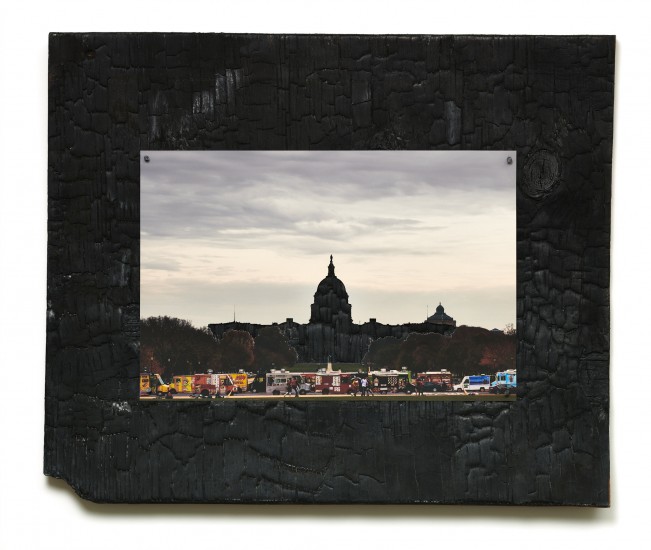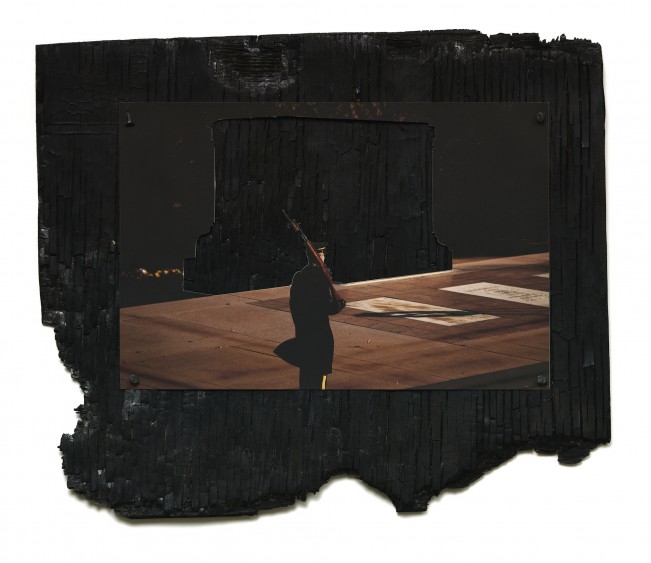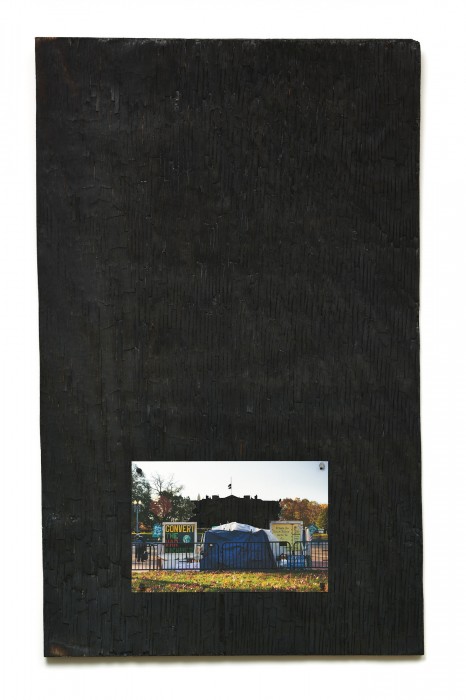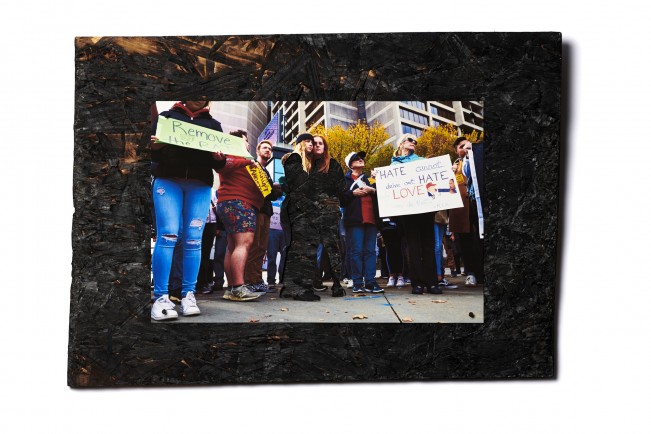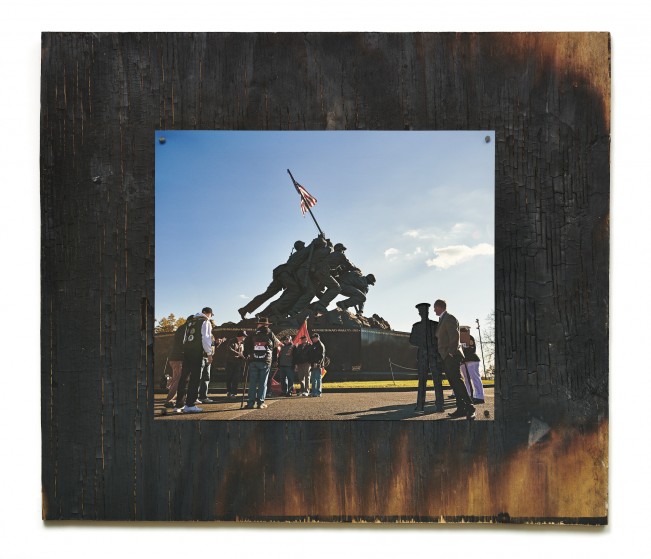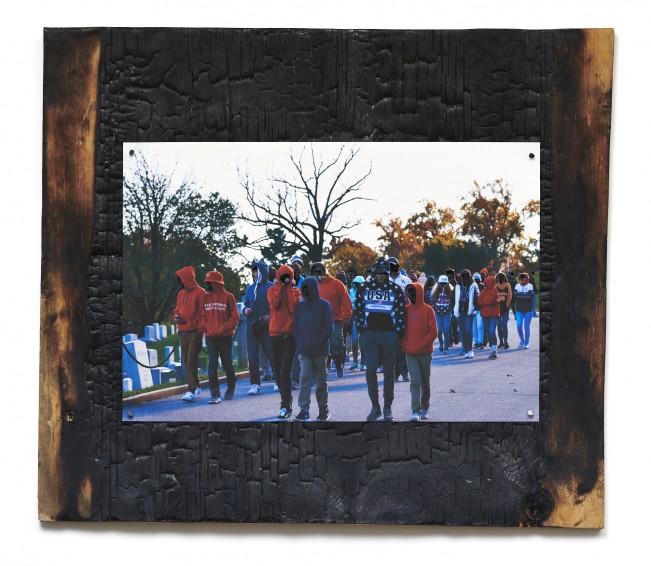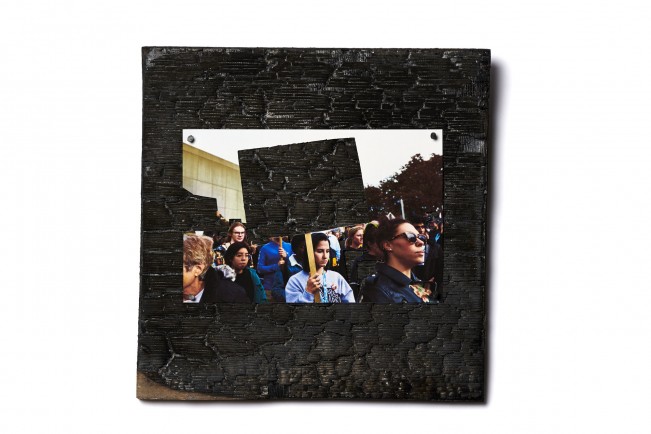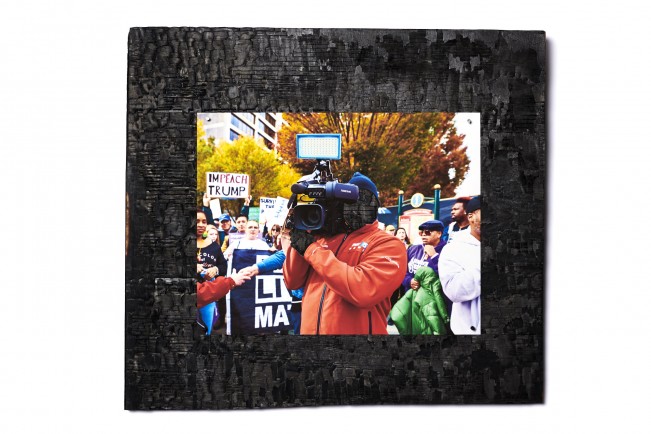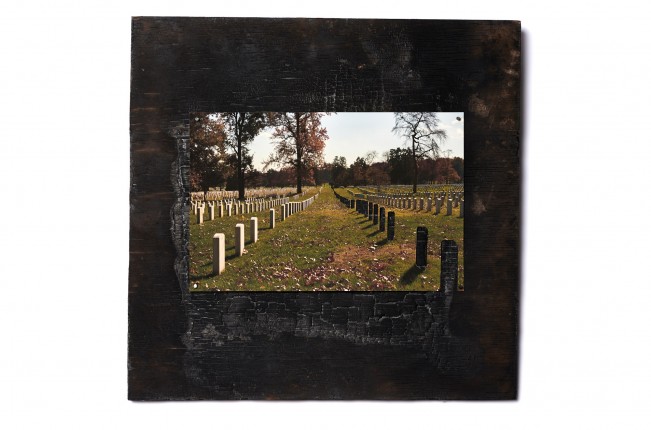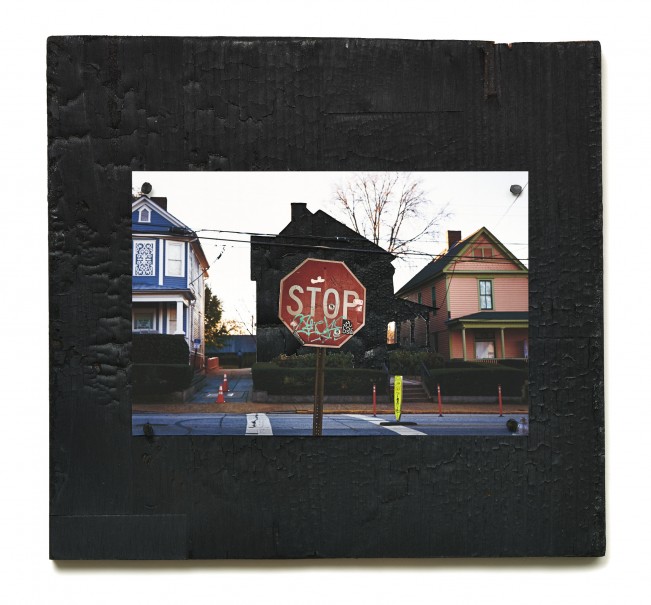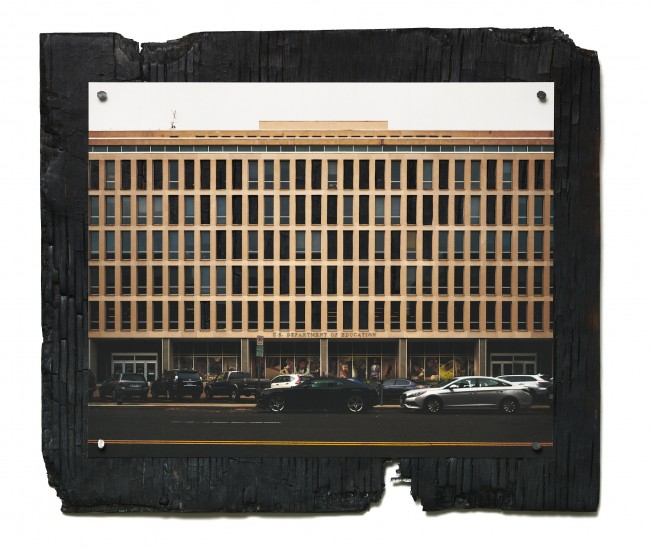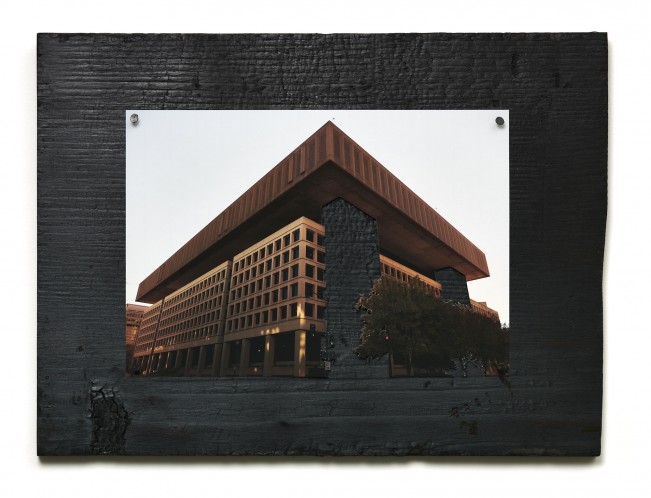Santiago Vanegas: UN TE ST ES O AM R CA
The work of Santiago Vanegas addresses mankind’s most challenging issues. Following a visit to Antarctica he created a major body of work concerning climate change. So it is no surprise that his latest project, UN TEST ES O AM R CA reflects the damage being done to traditional American values in today’s polarizing political climate.
What is surprising is the way he has cast aside the superficial layers of fake news, claim and counter claim to reveal a deep underlying institutional sickness. He shows us the shocking truth by not simply using photography but by inventing a complex process which itself mirrors the malaise. This process involves several stages of destruction and aptly leaves behind black charred remains.
The result is a series of one-of-a-kind images where the technique invites us to study each one closely, leading overall to a disturbingly thought provoking body of work.
Santiago Vanegas brings an interesting set of aesthetics to his work. He has navigated in and out of two cultures throughout his life. Born in Philadelphia and then moving back and forth between the United States and his native country of Colombia, eventually staying in Colombia for the next 14 years. Inspired by his mother, a painter, Surrealist art, Latin American magic realism, music, and the world of cinema, Santiago creates work that looks at the dark and the light in life. “I see the world in a way that even to me is a bit strange, but very real. The world is a strange, complicated, and fascinating place. I draw metaphors of how I see the world and its future.”
His work has been featured in Surface Magazine, WIRED, Flaunt Magazine, TALLULAH Magazine, HEDGE Magazine UK, Featherstitch Avenue, Picture Magazine, GRAPHIC Magazine UK, Hartsfield Jackson Atlanta International Airport, Lenscratch. Santiago is also principal photographer at featherstitchavenue.com. Santiago is currently based in Atlanta, GA.
Your work tackles an issue that is very much ‘of the moment’ in the USA. I know that you have visited Antarctica and also exhibited work on climate change. For our readers, let’s take a step back and find out how and when this all began? For example is your work mainly driven by the big issues facing humanity such as political or cultural change?
I worry about my kids’ (and humans’) future. Before becoming a parent I had my concerns about humanity’s choices. For the longest time, the environment hasbeen my #1 concern. Now it’s #2. Our democracy is not what we thought it was and is now rapidly slipping through our fingers. All of those “pillars of democracy” are either crumbling, or were never as robust as we thought… or both. I believe most citizens are good people who want to live in peace, health, and with fair opportunity. But even with that majority, democracy is failing us. Greed, corruption, lies, and lust for power is the norm. As long as our government does not represent the the people, none of the our current emergencies can be solved in an effective and lasting way.
After the 2016 presidential election, I was overwhelmed with a feeling of helplessness and irrelevance as a citizen and an artist. For a while I convinced myself that art was a hopeless effort. The future looked dark, and my work…pointless. Until one day, I got a photo project idea that is now UN TE ST ES O AM R CA. Only then did I feel, “I must do this”. It might not save democracy, or our dying Planet, but at the very least I’ll rise and be heard. And *that* is the first step in democracy.
Your choice of how the work is presented (on charred wood) is really innovative. Can you tell us your creative process for generating ideas in the first place? Do months tick by while the concept marinates? Do you write to flesh out the original thought? Or jump in and navigate as you go?
The only hard “method” I have is to have an open mind with myself. Whether it’s an art project, a scientific hypothesis, or getting dressed as a teenager in highschool, it’s very easy to censor ourselves. Fear is the enemy. Intuition is king. My best work has come from there. Whenever an idea happens I immediately write it down in my phone where I have a long list of random ideas. Years ago I used a physical “ideas journal”. It worked great, but I didn’t always have it with me. My phone is always within reach for documenting raw ideas at any given moment. There, they brew, mix, flourish or stay dormant… but they’re there. I don’t need to remember them.
Beyond that first spark I’ll draw, write, start shooting, or talk about it with someone. Talking about an idea and hearing it out loud is a great gauge of where to go next. Any combination of those can take any amount of time. Years, months, days, or seconds. Again, intuition is king.
Let’s move on to the overall process. Please tell us a little about how you create the images and also how the construction phase works where you need to char the wood, mount the prints…etc.
Where other projects have been loose and organic, this one has a well defined structure. It all starts with the concept: UN TE ST ES O AM R CA, a reflection of our country. It’s an image of what we stand to lose, and what may already be lost.”
From there I photograph scenes I feel have elements that show an American virtue in historical and government sites, sociopolitical events, pop culture, etc. As I shoot I ask myself, what is that “virtue”?… that I’ll later cut out with a razor. Let me take you through a specific image.
In this photo, people were protesting the president’s visit in Atlanta. There were lots of banners, signs, chanting. The couple in the middle of the frame haunted me. One staring at me while the other looked away. I love this photograph so much, yet what to cut out wasn’t as clear as some of my previous “place” images. Everything in this image had a purpose. Should I remove the signs? Take out the faces?
The two women together, their love, courage, strength and perseverance is powerful. I decided to cut out their bodies and leave their faces. I made this choice to show how women – especially homosexual women- still don’t have full control of their sexuality, their bodies, or their rights. Their faces remain because even while struggling for centuries, they’re still standing, fighting for equality.
I always use a new razor blade for each print, a big magnifying glass, plenty of light, and time for extraction. It’s a painstaking process of deliberately deconstructing a photograph, with precision. At first that process of cutting was just a means to an end, but after a while I realized that surgical removal is exactly what is happening in this country. Institutions, government branches, history, citizens’ rights, are being removed before our eyes in the most deliberate way.
I use panels of reclaimed wood. I burn them until charred black in my backyard. An act of destruction. Chaotic, but controlled. It’s no accident that the wood is burnt. I’m destroying a thing intended for *building*. Then, nailing the print to the wood. I’m very careful with my finished prints, yet now I’m laying down this photograph on charred wood to stab it with nails. The panel is slightly bent out of shape from the fire, so it doesn’t lay flat on my table, making hammering potentially messy. I use irregular “ugly” nails. With each hammer strike, ash and burnt chips fall off the wood. When finished, black ash is everywhere. It’s on my hands, table, floor, and all over the print. The process of making these pieces is one act of violence after another. An unpleasant, yet sometimes a cathartic experience.
The art itself, even when finished, is deteriorating. Art imitating life, or is it the other way around?
You already have a series of two dozen images mounted on wood. Is the project now complete or will you continue and perhaps extend the scope of the work? What is the hardest part that you encountered?
There are more places and subjects to explore. More vanishing American virtues to be found. It’s not finished, but I want it to be seen as I make it. The subject is too urgent for me to only reveal it when it is done. The biggest challenge has been to figure out an audience. This project doesn’t hinge on beauty. It’s a slap in the face. A warning. It requires a kind of audience I haven’t explored in my past work. Finding it will be interesting, but the fact I’m out of my comfort zone is a very good thing for the evolution of my photography.
Who were your early influencers and for this body of work, have you had any mentors who’ve helped you navigate along your journey?
My all time favorite visual artist, album cover designer Storm Thorgerson. His design of Led Zepplin’s “Presence” LP centers on a single mysterious pitch blackobject. However, careful inspection will reveal that in fact there is no object at all. The “object” is simply a shape cut out from the original photograph, thus implying the “presence” of a mysterious black object. I was listening to that LP one day and the idea of what is now UN TE ST ES O AM R CA hit me. So it’s definitely a riff on Storm’s creation. Later I came up with the burt wood, the nails, shooting subjects, etc. My mother has been my greatest mentor. She’s a painter, and also practices Tai Chi. She once told me that its essense is that the entire body is in constant motion *always*. There isn’t a single Tai Chi move where a body part is static. She
said, an artist should do the same. Always in motion. It doesn’t matter what you do, just do. If you’re in a rut, don’t stop. Keep moving, even if it sucks or feels irrelevant. If you’re on a high, also keep moving. That constant motion can be gentle, ferocious, controlled, chaotic, anything. As long as you are not static. So, I do.
Who on the current photographic horizon excites or interests you creatively?
Reuben Wu and Kurt Tong. Wu’s work with drone lighting in landscape is sublime, simple, clever, and masterfully executed. I’ve seen a few imitators, but none come close to Wu’s artistry. It’s one of those “I wish I would’ve thought of that” projects. I met Kurt Tong at Review Santa Fe and have been a fan of his work since. Kurt’s artistic journey from childhood to where he is now is fascinating. “Combing for Ice and Jade” is a particularly beautiful project that in my book, puts him in a category of *artist* (not “just” photographer), where the camera is simply one of his tools. It’s a category I hope to arrive at with my own work.
Visual artists often have other artistic interests. For example a large number of photographers were also musicians. Do you have any interests or hobbies which you feel help the way you see and think? Who are your favorite artists? (any discipline, painting, dance, sculpture, music, author…)
I jokingly call myself a “guitar owner”. I’ve been playing (owning) for about 25 years. I started by learning to play songs, but now I mostly improvise. Someone described to me what meditation is and realized that when I play guitar, it’s actually meditation. I’ve also been an avid music collector (cds and vinyl) since I was about 9 years old. Music, not photography, is the biggest influence and inspiration on my work. For me, music’s edge over photography is that it’s kinetic. The energy, emotion, and movement of musical performance (and its audience) is a phenomenon that continues to blow my mind. I have such high regard to the creation of music that it’s probably why I never fully pursued it as a career. Making music is like a super power. I find it so magical that my fear of not being able to make sounds that lift my soul ultimately makes that dream just a dream. I still very much love to play my guitar at home and disturb the neighbors though. Photography on the other hand, is a medium that for some reason comes more naturally to me. It doesn’t scare me like music does. It’s hard work, but it’s not emotionally terrifying like music. Maybe someday I’ll find the courage to make some music and incorporate it into my photography. Regardless of medium, some of my favorite artists are Christo and Jeanne Claude, Pink Floyd, Stanley Kubrick, Storm Thorgerson, Jean Michel Jarre, Gerard Richter, Olafur Eliasson. All have one thing in common. They’re fearless and are in constant evolution.
Thank you and finally, you are clearly on an exciting journey. Where do you go from here?
I’ll continue to work on this project. Being that it’s my first attempt at mixed media, I’m now exploring other projects ideas that are not “straight” photography. I’m exploring different print formats/materials, video, sound (hint…maybe music?), but all involving the camera at its core. And thanks for the interview, and to LENSCRATCH.
Olaf Willoughby is a photographer, writer, and educator living in London, UK. He teaches in the UK and the USA and his work has been featured in fine art and photo magazines and exhibited in UK, US and European venues. It has also been endorsed by The World Wildlife Fund in Australia who distributed 5,000 ebook copies of Olafs’ book, ‘Antarctica, A Sense of Place’ to help raise money for environmental causes. Olaf has created several other books, ‘Visualising Poetry’ and ‘On Tongue Tip Turn a Thousand Times’ which combines abstract photography with haiku poetry. He is a founder member of The Leica Meet a Facebook Group with over 16,500 members and has been closely involved in their fine art books, ‘A selection of Excellence’. His interest in storytelling also extends beyond photography. He has spoken on the art of using storytelling to improve business communications on various platforms in London, Basel, Amsterdam, Shanghai, Athens, and Chicago.
Posts on Lenscratch may not be reproduced without the permission of the Lenscratch staff and the photographer.
Recommended
-
Ragne Kristine Sigmond: Portraits of Painterly LightDecember 2nd, 2025
-
Mary Pat Reeve: Illuminating the NightDecember 1st, 2025
-
Ricardo Miguel Hernández: When the memory turns to dust and Beyond PainNovember 28th, 2025
-
Pamela Landau Connolly: Columbus DriveNovember 26th, 2025
-
MATERNAL LEGACIES: OUR MOTHERS OURSELVES EXHIBITIONNovember 20th, 2025

